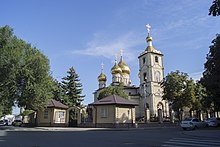|
Religion in Circassia
Religion in Circassia refers to religious presence in historical Circassia and modern-day Adygea, Kabardino-Balkaria, Krasnodar Krai and Karachai-Cherkessia. The majority of ethnic Circassians today are Muslim while a minority retain Orthodox Christian or pagan beliefs.[1][2] HistoryCircassia gradually went through following various religions: Paganism, Christianity, and then Islam.[3] PaganismThe ancient beliefs of the Circassians were based on animism and magic, within the framework of the customary rules of Xabze. Although the main belief was Monistic-Monotheistic, they prayed using water, fire, plants, forests, rocks, thunder and lightning. They performed their acts of worship accompanied by dance and music in the sacred groves used as temples. An old priest led the ceremony, accompanied by songs of prayer, consisting of meaningless words and supplications. Thus, it was aimed to protect the newborn babies from diseases and the evil eye.[4] Another important aspect was ancestors and honor. Therefore, the goal of man's earthly existence is the perfection of the soul, which corresponds to the maintenance of honour, manifestation of compassion, gratuitous help, which, along with valour, and bravery of a warrior, enables the human soul to join the soul of the ancestors with a clear conscience.[5] JudaismDuring the 8th century, some Circassian tribes converted to Judaism, as a result of good relations with the Khazar Khaganate and the settlement of approximately 20,000 Jews in Circassia.[4] However, the practice of Judaism later declined significantly, following conversions to Christianity and Islam.[citation needed] The Circassians have co-existed with Jewish community of Nalchik for years. And during the 1990's the Jewish population in Circassia declined in most areas due to Immigration to Israel[6] Today there is a small but growing Jewish population in Sochi.[7]
Christianity It is the tradition of the early church that Christianity made its first appearance in Circassia in the 1st century AD via the travels and preaching of the Apostle Andrew,[8] but recorded history suggests that, as a result of Greek and Byzantine influence, Christianity first spread throughout Circassia between the 3rd and 5th centuries AD.[9][10][11] The spread of the Catholic faith was only possible with the Latin Conquest of Constantinople by the crusaders and the establishment of the Latin state. The Catholic religion was adopted by the Circassians following Farzakht, a distinguished figure who greatly contributed to the spread of this religion in his country. The pope sent him a letter in 1333 thanking him for his effort, as an indication of his gratitude. For Circassians, the most important and attractive personality in all Christian teachings was the personality of St. George. They saw in him the embodiment of all the virtues respected in the Caucasus. His name in Circassian is Awushidjer (Adyghe: Аушыджэр) or Dawushdjerdjiy (Adyghe: Даущджэрджий). Christianity in Circassia experienced its final collapse in the 18th century when the majority of Circassians were converted to Islam. The ex-priests joined the Circassian nobility and were given the name "shogene" (teacher) which over time became a surname. Many Circassian families are descended from these priests, some of Greek origin and some of Roman. Significant Christian and pagan presence remained among some tribes such as the Shapsugs and Natukhai with Islamization pressures implemented by those loyal to the Caucasus Imamate.[12] Sufi orders including the Qadiri and Nakshbandi orders gained prominence and played a role in spreading Islam.[13] Among Christians, Catholicism, originally introduced along the coasts by Venetian and Genoese traders, today constitutes just under 1% of Kabardins,[14] notably including those in Mozdok[15] and some of those Kursky district.[16] Notable Circassian Christian figures include Teresa Sampsonia,[17]: 390 [18] Alexey Cherkassky,[19] Alexander Bekovich-Cherkassky,[20] and Maria Temryukovna.[21] IslamA small Muslim community in Circassia has always existed since the Middle Ages, but widespread Islamization occurred after 1717.[22] Travelling Sufi preachers and the increasing threat of an invasion from Russia helped expedite the process of the Islamization of Circassia.[22][23][24] Circassian scholars educated in the Ottoman Empire boosted the spread of Islam.[25] Circassian elders saw some elements in Islamic tradition as the influences of foreign culture and rejected them, and while Circassians were Sunni Muslims officially, most Circassians were non-denominational and only accepted the Sunni practices after being exiled. Contemporary eraAdygeaAccording to a 2012 survey which interviewed 56,900 people,[26] 35.4% of the population of Adygea adheres to the Russian Orthodox Church, 12.6% to Islam, 3% are unaffiliated Christians and 1% are Orthodox Christian believers who don't belong to church or are members of other Orthodox churches. In addition, 30% of the population declares to be "spiritual but not religious", 9% is atheist, and 8.6% follows other religions or did not answer to the question.[26] Kabardino-BalkariaAccording to a 2012 survey which interviewed 56,900 people,[citation needed] 70.8% of the population of Kabardino-Balkaria adheres to Islam, 11.6% to the Russian Orthodox Church, 1.8% to Circassian paganism and other indigenous faiths, 3.8% are unaffiliated generic Christians. In addition, 12% of the population declares to be "spiritual but not religious", 5.6% is Atheist or follows other religions including Jehovah's Witnesses.[citation needed] Krasnodar KraiAccording to a 2012 survey[citation needed] 52.2% of the population of Krasnodar Krai adheres to the Russian Orthodox Church, 3% are unaffiliated generic Christians, 1% are either Orthodox Christian believers who don't belong to church or members of non-Russian Orthodox churches, and 1% are Muslims. In addition, 22% of the population declares to be "spiritual but not religious", 13% is atheist, and 7.8% follows other religions or did not give an answer to the question.[citation needed] Karachay-CherkessiaAccording to a 2012 survey which interviewed 56,900 people,[citation needed] 64% of the population of Karachay-Cherkessia adheres to Islam, 13% to the Russian Orthodox Church, 2% to the Karachay and Circassian native faith, 2% are unaffiliated Christians, unchurched Orthodox Christian believers or members of non-Russian Orthodox churches. In addition, 10% of the population declares to be "spiritual but not religious", 3% are atheist, and 6% are other/undeclared.[26][27] References
|
